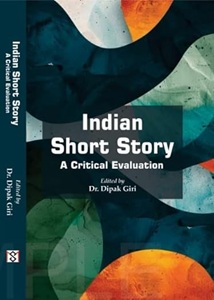Sapna Dogra
Sapna Dogra

Indian Short Story : A Critical Evaluation | Literary Criticism |
Dipak Giri (Ed) | New Delhi: Malik and Sons (2024) |
ISBN 978-93-92459-85-6 | Pp 237 | ₹1,050
The book Indian Short Story: A Critical Evaluation, edited by Dipak Giri is an interesting addition to the academic exploration of Indian Short Story as a genre. As the editor spells out in the Introduction of the book: “…this present book is an endeavour to compile the works of major Indian short story writers in a short but comprehensive way in order to supply the best possible materials to readers, writers, academicians, scholars and students who wish to do further studies in this field”. The volume compiles twenty-six research papers on modern Indian short story writers and their works, including those by Mahashweta Devi, Rita Garg, and others.
In “Mapping Motherhood in the Selected Short Stories of Mahashweta Devi” Dr Sachi Sood explores motherhood as it is portrayed in the stories of Mahashweta Devi. The paper investigates the anti-patriarchal conception of motherhood which helps in re-examining the popular but limiting conception of motherhood.
In the paper “Qurrantulain Hyder’s Works: A Study of ‘Aag Ka Darya’” in Terms of Temporal and Spatial Dimensions” Dr Shantanu Siuli examines the chronological and spatial aspects of the novel Aag ka Darya. The author asserts that the papers attempt to “comprehend the complex ways through which Hyder moves between different times and places. By considering its structure, narrative devices and symbolic elements, this paper seeks an understanding of how Hyder creates a multilayered story that blurs the distinction between past and present, reality and myth. This Indian philosophy perceives time as ‘Kalchakra’ or wheel of time, implying that Aag ka Darya’s concept of time is not linear but cyclical”. (17)
In her paper “Tales by Rita Garg: A Review”, Dr Pinki Arora analyses child-centric issues in Garg’s stories. Arora looks at the issues such as mythological orientation, crime, poverty, etc.
In his analysis of Ruskin Bond’s The Tiger in the Tunnel, Samin Reza’s paper closely examines the story from a psychoanalytical and psychosocial perspective. The author says “Engaging Lacanian psychoanalysis in the interpretation of the story explores the psychological and symbolic underpinning of the narrative with a particular emphasis on the symbolic order, the father’s role, and the process of identity formation.”
In “(The) Mind in Not an Artist’s Brush. . . but an Ordinary Camera that Records Reality as it is: Social Hierarchy and Body Politics in Ismat Chugtai’s Lihaf” by Baidehi Mukherjee looks at how the binaries of class and hierarchy play a seminal role in studying the body politics as depicted in ‘Lihaf’. The author opines that “the hierarchical politics which is a significant representation of the sexual/body politics is a vital trope to be negotiated in Lihaf. The titles of the ‘Nawab’ and the ‘Begum’ necessarily join an interrelationship to the societal strata that they are a part of” (54). Baidehi concludes that Chugtai “has reflected the female consciousness in her stories, which is a new cosmic and social reality that had emerged from the pre-independent times in the context of Indian short stories” (62).
Ankita Saren and Srijani Ganguly in their paper “Navigating Solitude and Social Divide: A Critical Analysis of Rabindranath Tagore’s ‘The Postmaster’” examine Tagore’s poignant tale from the perspective of theme, character, narrative style and cultural context.
Aryas Sigh’s paper deploys Homi Bhabha’s theories of mimicry and third space to delve into Salman Rushdie’s short story “The Courter”. The author states at the beginning of the paper “In this essay, I aim to place Rushdie’s story within the framework of post-colonial discourse and Bhabha’s idea of mimicry, explaining the relationship between linguistic hybridity and the ambivalence of colonial mimicry.” The paper focuses on Rushdie’s use of language and cultural identity.
In “Undead Wisdom: Cultural Fears and Nuanced Monstrosity of the Vetala in Somadeva Bhatt’s Kathasaritasagara” authors Shajith MS and Dr G Bhuvaneshwari opine that “... duality of nature, where monstrosity is both a consequence and a manifestation of transgressions against societal norms in the past, creates a complex interplay between fear and moral judgement.” The paper looks at the Western and the Eastern concept of monsters and states that “Unlike their Western counterparts, monsters in Asian literary traditions are not typically regarded as an absolute otherness against which individuals must defend themselves” (41).
Other than these the book offers essays on RK Narayan, Anita Desai, Saadat Hasan Manto, Sowvendra Shekhar, Saurabh Kumar Chaliha, Sirshendu Mukhopadhyay and Mulk Raj Anand.
This volume’s wide range of themes will help readers develop their critical thinking abilities and gain a deeper comprehension of Indian short story writers. The book presents a rich tapestry of critical perspectives and is an essential resource for scholars, students, and anyone interested in understanding contemporary Indian Short Story.

Issue 122 (Jul-Aug 2025)
-
EDITORIAL
- Sukanya Saha: EDITORIAL
-
REVIEWS
- Aparna Singh: 'Across the Luminous Realms and Other Stories' by Louis Couperus (Dutch original), Trans. by Chaitali Sengupta
- Dhrishni Saha: 'Money Doesn’t Grow on Trees' by Lavanya Mohan
- Himank Garg: 'Nocturne Pondicherry—Stories' by Ari Gautier (French original), Trans. by Roopam Singh
- Madhavi Latha: 'Indian Diaspora Literature—A Critical Evaluation', Ed. by Dipak Giri
- Sachidananda Mohanty: 'The Scrapper's Way—Making it Big it in an Unequal World' by Damodar Padhi
- Sapna Dogra: 'Indian Short Story—A Critical Evaluation', Ed. by Dipak Giri
